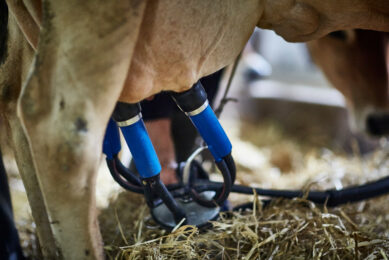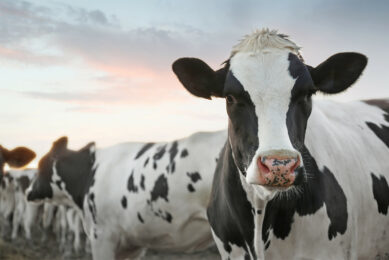Cow health: ‘Prevention remains the basis, despite vaccinations and antibiotics’

Vaccines against mastitis and Mortellaro’s disease are still a long way off, says Gerald Behrens of pharmaceutical company Boehringer Ingelheim. mRNA vaccines are far too expensive for livestock farming. From a social point of view, the antibiotic discussion has entered calmer waters, but could flare up again at any time.
Gerald Behrens has been at the top in the world of research into food additives, vaccines and medicines for animals for 30 years. “When I started in the late 1990s, I listened with admiration to the scientists who sketched the future. They predicted that by 2010, production animals would be resistant to most diseases with the help of vaccinations or even genetic modification. This was the time when genome unraveling started. It seemed like the gold rush. Of course, scientists must be ambitious; they need vision. But not much has come of it.”
Where did it go wrong?
“The matter turned out to be much more difficult than expected. Of course, a lot has become possible with vaccines. Look how fast the Covid vaccine was developed, very quickly from BioNtech. Also look at what Boehringer Ingelheim did with the Border Disease Virus (BVD) and Circo virus in pigs. These 3 vaccines are gamechangers, but also exceptions. There is still no widely effective vaccine against mastitis.”
That seems be the holy grail for pharmaceutical companies?
“It sure is. A lot of research money has disappeared into it without yielding real results. The few currently available vaccines are very limited in their spectrum. Science may be much further than 30 years ago, but it has mainly learned that disease is something very common. That it is much more difficult to respond to than they had hoped. Prevention is and remains the basis, despite all vaccinations and antibiotics.”
Great progress been made with antibiotics, right?
“Certainly. Compare the situation today with that of 5 or 10 years ago. Consumption has fallen significantly in Northwest Europe due to legislation and because the entire pharmaceutical industry has worked in 2 directions. First, it has provided the primary sector with data so that it understands that excessive or standard use of antibiotics is pointless, and even leads to unnecessary losses. In addition, it has made policymakers and consumers aware that not treating animals is unacceptable. You need some antibiotics because you do not want animals to suffer and die unnecessarily. There is now agreement that, even in organic farming, use is permitted under restrictions.”
Is the antibiotics discussion over now?
“No, it will always flare up, mainly because NGOs want to show that they still exist. You can wait for a new wave of media reports about multidrug-resistant strains of bacteria and people dying from them in hospitals. And all of this as a result of excessive use in the food production chain. That is certainly not the cause. We can demonstrate this with data, including how much has already been reduced and that we are still working on it. That is why we must continue collecting data, but maybe we can put the file aside for a while.”
And for cattle, for example against mastitis?
“It is about what you expect. Our internal benchmark is our BVD vaccine. Complete prevention, and an effectiveness of more than 99.99%. Only then will farmers want to pay a premium. If they can keep their cows guaranteed free from mastitis with 1 vaccination per year, dairy farmers will want to invest in this. But there are many causes for mastitis, not just one. Think of different coli, staphylococci, streptococci, you name it. That is why a single, broad vaccine is still so far away. We are replacing antibiotics with preventive vaccination, better biosecurity and better protocols. Teat sealers are used on a large scale. Outside Europe, there are still plenty of livestock farmers who think: ‘I want safety; just put an antibiotic blanket over the dry cows. But there, too, more and more livestock farmers realise that in 4 out of 5 cases a blanket of teat sealers is often sufficient, and occasionally a drying agent.”
Will there be mRNA vaccines in animal husbandry?
“Yes, for economically relevant diseases. Especially if you need a quick solution in the case of sudden outbreaks of new diseases, such as what happened with Covid-19. In such a situation, an mRNA vaccine is the technology to look at. Because then those affected or threatened will be willing to pay the high additional price. Whether they want to do that in the long term remains to be seen. Costs remain crucial in livestock farming.”
In which fields do you expect innovation?
“We are improving the existing vaccines to the level that you can conduct eradication programmes with them. This is possible with our current BVD vaccine, for example. Of course we would like to eradicate mastitis or Mortellaro’s disease. But Mortellaro’s disease occurs on the hoof, in places that are hardly permeated with blood. That is a place where a conventional vaccine does not work. The problem is the barn floor – the cow is not built for that humid environment. So you do not have to think about vaccines for that, but you have to adjust the entire barn design, get rid of concrete floors and switch to a sand surface.”
Given the recent introductions, will Boehringer Ingelheim focus more on intestinal diseases?
“No, we have to remain focused. First and foremost, we look at marketability and our own knowledge. So, mastitis, checked. Mortellaro, the same. That is why we produced the vaccine against calf diarrhoea. Our upcoming introductions will again be in the respiratory area because those are the easy targets. The causative agents are very well defined, as is the pathology. You can approach the virus or bacteria through the bloodstream in a targeted manner. I foresee new vaccines aimed at respiratory infections in calves because many antibiotics are still used against that. Some scientists estimate that Lumpy Skin Disease will become relevant in Europe. I doubt that, but there are enough vaccines out there to make better versions of it. Now, I do not see any concrete candidates, but yes, the corona virus has also surprised us. It was always among us, but it did not make us sick.”
Boehringer Ingelheim has 3 pharmaceutical branches: for humans, pets and production animals. Will it stay that way?
“When I started here in 1990, the sales turnover for veterinary medicines was €200 million. Pets were secondary. Now, only a third of our €4.5 billion turnover in veterinary medicines is for production animals. We are second or third worldwide in veterinary medicine. So, scale is not an issue. There is definitely synergy between the human and the pet branch. Boehringer Ingelheim is strong in ageing medicines in humans as well as in cardiovascular and respiratory diseases, and diabetes. We also increasingly play a role in medicines for dogs and cats. There is less synergy between dogs and cats on the one hand and pigs and cows on the other, and these medicines are marketed through completely different channels. It is also clear that innovations on the pet side, partly driven by the humane side, are moving faster than in livestock. Margin development is always downwards, patents are expiring. Without innovation, margins erode, and you become a commodity player. The owner’s top management does not want that – that has become clear several times. They want to be among the first to take steps. Leading the way instead of following.”
Will you buy innovation?
“That is also an option. That is why we are looking at other companies, especially in sensor technology. Automatic data collection and thus prediction and action. That will be a major driver in future agriculture. Does Boehringer Ingelheim want to play a role there? I say yes, but through acquisitions of companies that continue to develop businesses independently. We must remain focused on our core business.”
Join 13,000+ subscribers
Subscribe to our newsletter to stay updated about all the need-to-know content in the dairy sector, two times a week.










